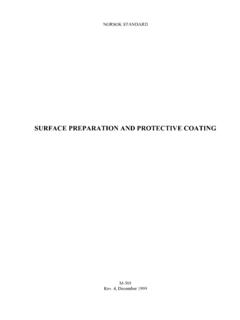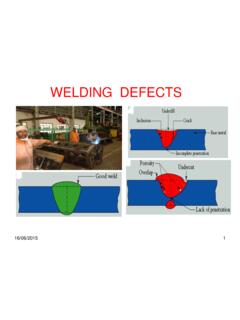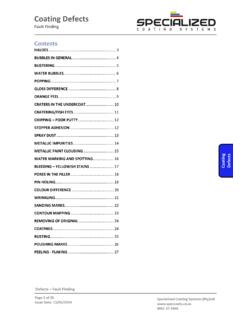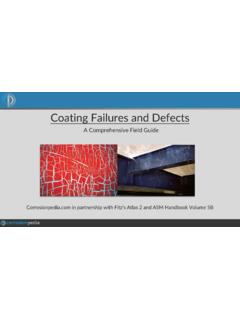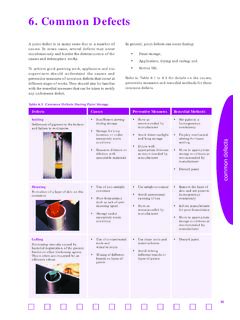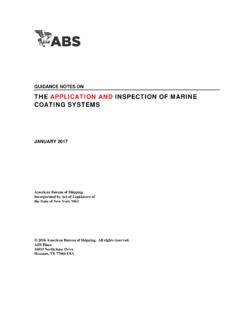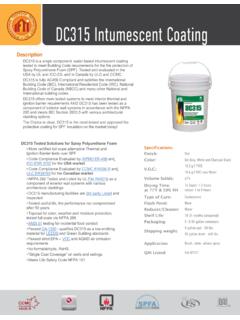Transcription of Spin-coating of Photoresists - MicroChemicals
1 Chapter01 MicroChemicals Fundamentals of of SPIN-COATINGDue to the high potential homogeneity and throughput, Spin-coating is by far the most common method for coating substrates with Photoresists . In addition to the advantages of this technique, this chapter also discusses common technical problems together with possible solutions. Techniques and Application AreasPrinciple of Spin-coatingIn this coating technique, typically a few ml of resist are placed (dispensed) on a substrate which is typically brought to a rotational speed of several 1000 rpm before (dynamic Spin-coating Fig. 53) or shortly thereafter (static spin-coat-ing).Due to the centrifugal force, the dispensed resist spreads into a uniform resist fi lm of desired fi lm thickness, excess re-sist is spun off the edge of the substrate. At the same time, a part of the solvent evaporates from the resist fi lm, so that its thinning stopped on the one hand and on the other hand, the resist fi lm becomes suffi ciently stable to suppress its elapsing during the handling of the wafers after Spin-coating of the resist typically takes only 10 - 20 sec-onds and permits the short cycle times of less than one min-ute required for industrial production, including dispensing and wafer resist fi lms attained by Spin-coating are very smooth, can be adjusted in their thickness very accurately and repro-ducibly, and show very good thickness homogeneity, at least for circular substrates (wafers).
2 Disadvantages and LimitationsEspecially with square or rectangular substrates, but also with circular substrates in the case of thick resist fi lms, the air turbulences at the edges and above all the corners of the substrate causes an acceler-ated drying of the resist which suppresses the spin-off of the resist at the corners and edges and causes a sidewall of resist near the substrate textured substrates, the thickness homogeneity of the resist fi lm suff ers. On the one hand, the resist can be pulled back from the edges of the textures, on the other hand spaces and holes can build up unin-tentional resist fi lm most of the dispensed resist is spun off , the yield of photoresist is very low, with typical only a few %, but this usually only plays a very minor factor in semiconductor manufacture and is only a signifi -cant cost factor for low-priced end products.
3 Infl uence Factors of the Resist Film ThicknessInfl uence of the Attained Spin SpeedIf, as usual, the Spin-coating of the resist from the substrate continues until it has been stopped by the drying process, the attainable resist fi lm thickness decreases in a good approximation with the reciprocal square root of the spin speed (Fig. 54).Thus a given resist allows a certain range in the attainable resist fi lm thickness. A doubling of the spin speed thus reduces the thickness of the resist fi lm by a factor of approximately , so that the fi lm thick-ness can be adjusted with a certain resist in a certain range by varying the spin 53: A resist dispensed on a rotating sub-strate thins out through the spin force until the drying of the resist through the evaporation of the solvent stops a further spin off .Substrate (Si wafer)PhotoresistRotation Chapter01 MicroChemicals Fundamentals of of many AZ resists, such as the AZ 1500, AZ 4500, AZ 9200 or AZ ECI 3000 series, the last two digits of the designation ( AZ 1518) indicate the fi lm thickness attained by spin coating at 4000 rpm (for some resists at 3000 rpm) in 100 nm units using the example of AZ 1518, uence of the Spin TimeIf the Spin-coating is stopped during the phase in which the resist is still being spun off the substrate, the resist fi lm thickness achieved can be adjusted over the spinning time.
4 The more viscous a resist is and the slower the spin speed is, the larger the cor-responding time window:As Fig. 55 shows, with conventional spinning speeds of 3000 - 4000 rpm with thinner resists like the AZ 6632, 3 m of fi nal resist fi lm thickness is completed after only a few seconds, with thick resists like the AZ 9260, 7 m is fi rst completed in about 20 sec-onds. The further thinning is based on the evapora-tion of the solvent during the spinning or the subsequent the attained resist fi lm thickness is very time-critical due to the interruption of the Spin-coating during the spin off , however, it is advisable, for reasons of reproducibility, to use a resist which achieves the desired fi lm thickness with conventional spin profi les (2000 - 4000 rpm for 20 - 30 seconds).Residual Solvent Content The residual solvent content in the resist fi lm also infl uences the resist fi lm thickness.
5 During spin-coat-ing, the remaining solvent concentration initially sinks rapidly and saturates to a value which usually de-pends on the resist fi lm thickness and the solvent used. Typical values of the residual solvent concentra-tion after Spin-coating are between approximately 10% (thin resists) to 35% (thick resists). Only at higher temperatures (softbake) does the concentration further decrease to approx. 3 - 5%, where especially in case of thick resist fi lms, substrate-near resist areas have signifi cantly higher values than areas near the resist ,500,751,001,251,501,752,000200040006000 8000 Spin Speed (rpm)Fig. 54: The attained fi lm thickness of an arbitrary resist (in arbitrary units, normalized to 1 at 4000 rpm) as a function of the spin 55: With highly viscous resists such as the AZ 9260 (left), the spin off of the resist at 3000 rpm takes approx.
6 20 s (ex-ternal diagram), slower spin speeds hardly further reduce the resist fi lm thickness (blue) attained after the softbake. The fi lm thickness measured immediately after Spin-coating (black) thins out further which is mainly due to residual solvent evaporating during the spin cycle (inside diagram). When a low viscous resist such as the AZ 6632 (right), the spin off is already completed after a few seconds. Chapter01 MicroChemicals Fundamentals of of evaporation rate of the solvent from the resist increases towards higher temperatures and the vis-cosity of the resist drops. Both eff ects have an opposite eff ect on the resist fi lm thickness attained, so that a change in the temperature by a few C does not mean too much variation in the attained resist thick-ness usual tolerable for uncritical In addition to temperature and air humidity, the solvent concentration of the atmosphere in the spin coater also infl uences the attained fi lm thickness: The more saturated the air, the lower the evaporation rate of the solvent from the resist fi lm, the longer the spinning off of the resist takes and the lower the resist fi lm thickness fi nally attained.
7 Thus after the cleaning of the coater of resist residues or after longer periods the coater has not been used, it may be useful to fi rst coat some dummy wafers in order to ob-tain a constant fi lm thickness for all subsequent wafer equipment itself has a great infl uence on the coating result: The use of a Gyr set (a cover rotating synchronously with the substrate) reduces the relative air movement over the substrate and thus the evaporation rate of the solvent from the resist fi lm, and can thereby reduce the attained resist thickness by a factor of two or more. The Edge Bead and Its Elimination or ReductionCauses and ResultsEspecially during the coating of thick resist fi lms as well as with square substrates, a so-called edge bead forms, that is, an edge elevation of the photoresist fi lm which is problematical in the case of contact ex-posure:Due to the high residual solvent content in the edge bead even after the softbake, the mask may stick to the resist fi lm.
8 The edge bead also acts as an unwanted spacer between the resist fi lm and the mask dur-ing exposure, which is often the reason for a poor resolution, wrong dimensions or an unintentionally low sidewall angle of the developed resist or EliminationIf an automatic edge bead removal is not possible, the following options can help reducing / eliminating the edge bead: For circular substrates: Dynamic edge bead removal at about 500 rpm with AZ EBR solvent (no sol-vent with high vapour pressure such as acetone!) from a wash bottle with fi ne spray nozzle The use of a resist which reaches the target fi lm thickness at suffi ciently high spin speed (3000-4000 rpm) Towards very thick resist fi lms: A higher spin speed for a short time A spin-off of the edge bead by an abrupt increase of the spin speed at the end of the coating , when the coating has suffi ciently dried, but the edge bead is still liquid enough for a spin-off.
9 A multiple coating of two or more resist fi lms on top of each other with each higher spin speed A waiting period between the resist coating and softbake dependent on the resist fi lm thickness and residual solvent content to prevent an increase of the existing edge bead by the sudden drop of the viscosity at the high softbake temperature (possibly multi-stage drying: Room temperature .. 50 C .. 95 C). A well-adjusted cavity in the substrate holder with the substrate as close inlay. In case of non-circular substrates: If possible, remove (break) the edge pieces of the substrate togeth-er with the edge bead, or wipe the edge bead with clean room wipers Inhomogeneous Resist Film Thickness and Resist DefectsTextured Substrates Chapter01 MicroChemicals Fundamentals of of two-stage spin profi le can be useful in order to attain the best possible homogeneity on textured sub-strates: The resist can be distributed over the textures of the substrate by a short Spin-coating at about 500 rpm so that it can then be thinned out to the desired fi lm thickness at higher speeds.
10 The spin-coat-ing at low speeds should not take longer than a few seconds to prevent a premature drying of the resist at this the attained coating result nevertheless is not satisfactory, an alternative coating method such as the dip coating or spray coating should be taken into SubstratesHere, the air swirling causes an accelerated drying of the resist at the edges and especially above the corners of the substrate which suppresses the spin off of the resist at these points and produces an edge bead of the resist (For details, see section ).EquipmentInhomogeneous resist coatings are often caused by unsuitable equipment: Openings in the cover of the spin coater cause turbulences over the resist fi lm during the rotation of the substrate, which result in a non-uniform drying of the same. It is generally recommended to cover these openings from the inside (e.)




